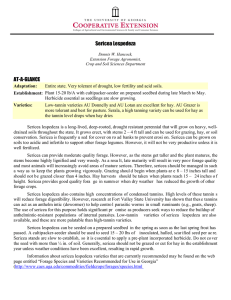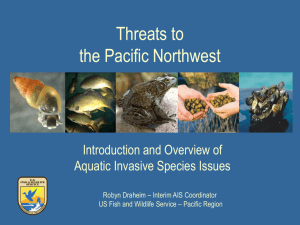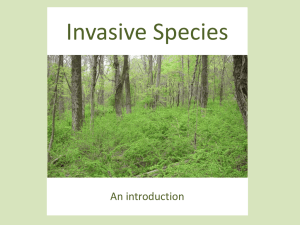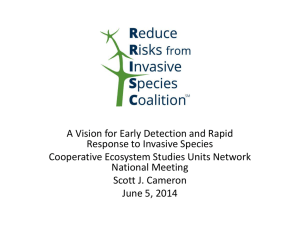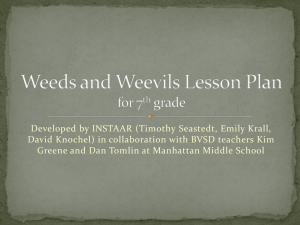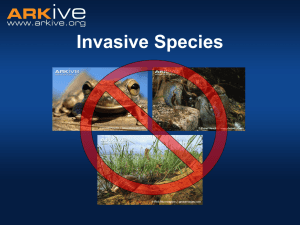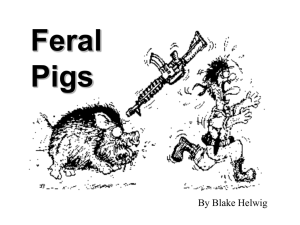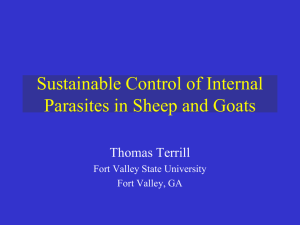Invasives 101 - Oklahoma Invasive Plant Council
advertisement
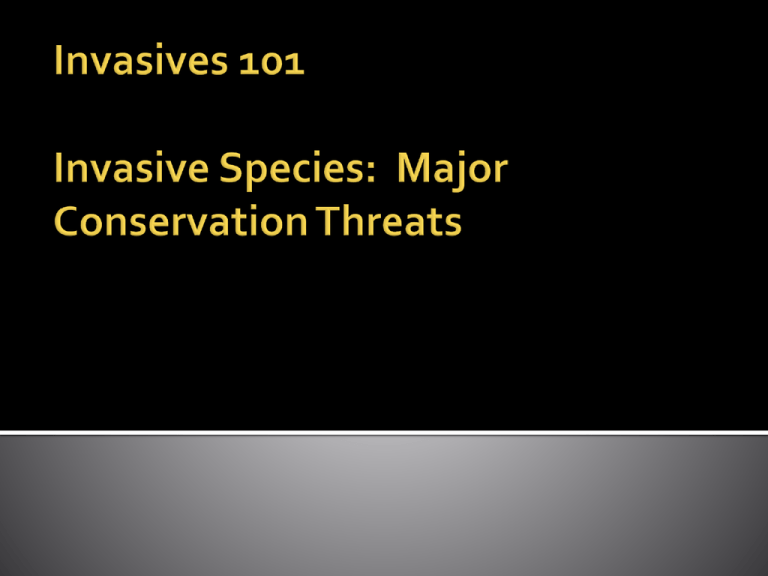
Threats: Loss of habitat Habitat degradation Inappropriate fire regime Inappropriate grazing regime Altered hydrologic regime Definition: ▪ They don’t belong in a given place ▪ They cause economic or ecological harm Invasive = causes ecological harm by outcompeting native species Exotic = not native, foreign Noxious = legally designated as undesirable Nuisance = inconvenient Altered local conditions can allow native species to bec0me invasive: eastern redcedar mesquite Bermuda grass tall fescue Old World bluestem sericea salt cedar eastern redcedar Chinese privet Japanese honeysuckle kudzu introduced intentionally ▪ ▪ ▪ ▪ ▪ as cattle forage – sericea for soil stabilization – kudzu, sericea as ornamentals – salt cedar, eastern redcedar for hunting/fishing – bait fish, exotic deer for invasives control - Asian grass carp escapees ▪ from pet trade – hydrilla, koi, feral cats ▪ from gardens or landscaping – honeysuckles, ornamental trees ▪ from livestock – feral hogs accidental hitchhikers ▪ in cargo – emerald ash borer ▪ in transportation vessels, vehicles – zebra mussel, aquatic plants altered natural regimes allow their entrance ▪ fire suppression – eastern redcedar, mesquite (based on invasiveness, difficulty of control, distribution, harm caused, etc.) eastern redcedar sericea Johnson grass Old World bluestem hydrilla salt cedar kudzu musk thistle privet field bindweed cheat grass multiflora rose feral hog zebra mussel Asiatic clam European starling house sparrow carp fire ant Tallgrass Prairie – SERICEA, Osage orange, feral hog. Sericea research. Nickel – SERICEA, Nepalese browntop, callery pear, multiflora rose, teasel, feral hog Pontotoc Ridge – SERICEA, EASTERN REDCEDAR, watercress, Johnson grass, feral hog, fire ant Four Canyon – salt cedar, revennagrass, Old World bluestem, Osage orange, black locust 700 acres PER DAY are lost to eastern redcedar in Oklahoma! TNC spends $100,000+ per year on sericea control… at Tallgrass Prairie Preserve alone. Invasives negatively impact rangeland, ag crops, recreation sites, industries, human health and native wildlife species Ignorance Apathy Cost Poor legal structure Lack of coordination among entities Poor information Preserves have active programs of control Public lands - sporadic efforts State noxious weed law Private land efforts: If affordable/economic impact Aerial spraying Limited nuisance efforts OkIPC Based on TNC Invasive Plant Audit for the state - 2009 Mission is to facilitate efficient and effective management of invasive plant species for the protection of the economic and natural resources of Oklahoma ‘s private and public land and water. Identify invasive species in OK and assess their threat. Educate and create awareness. Encourage legislative and regulatory improvements that increase invasive plant control effectiveness in the state. Promote coordination among stakeholders. Serve as a clearinghouse of information Encourage sources of funding for invasives education and management. TNC OSU OK Native Plant Society OK Farm Bureau ODWC OK State Parks NRCS OK Dept of Ag Noble Foundation OK Conservation Commission OK Assoc of Conservation Districts OK Nursery and Landscape Assoc OK Biological Survey US Army Corps of Engineers Developing lists of invasive plants Meeting with 30+ entities involved with invasive plants Developing education/awareness programs for various audiences Working with legislature to improve OK noxious weed law Developing training for invasives ID Created website Invasive species are a major threat to conservation of native species It will take a great deal of effort and funds for control Early detection is key to future “invasions” management Management will require efforts by all in Oklahoma Education will be critically important Invasive species will be a major conservation problem… Everywhere… Forever! But we have to do all that we can do to manage them if conservation is to be successful!
